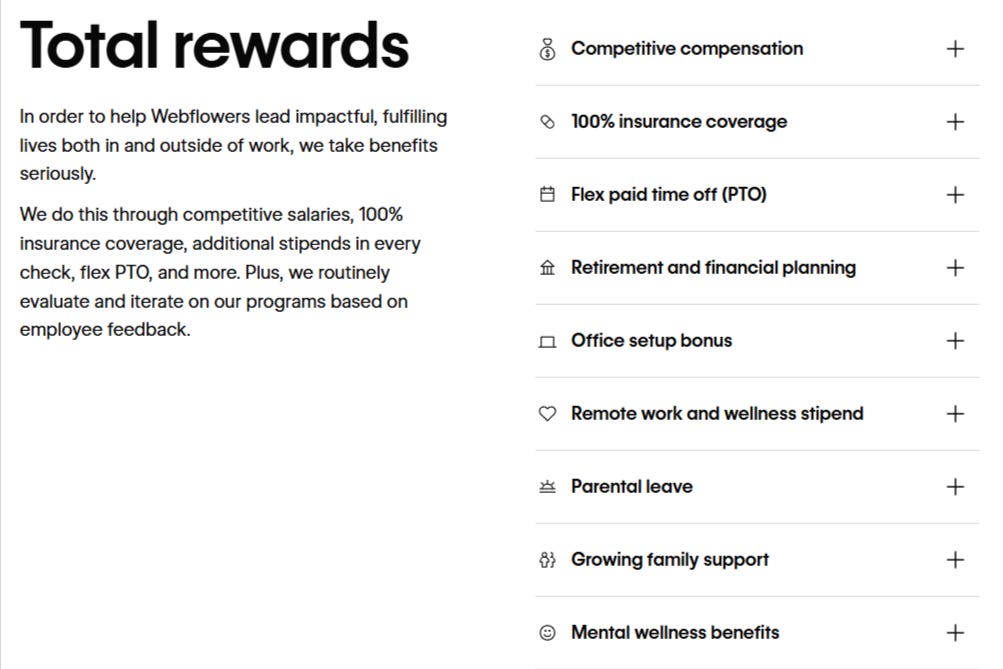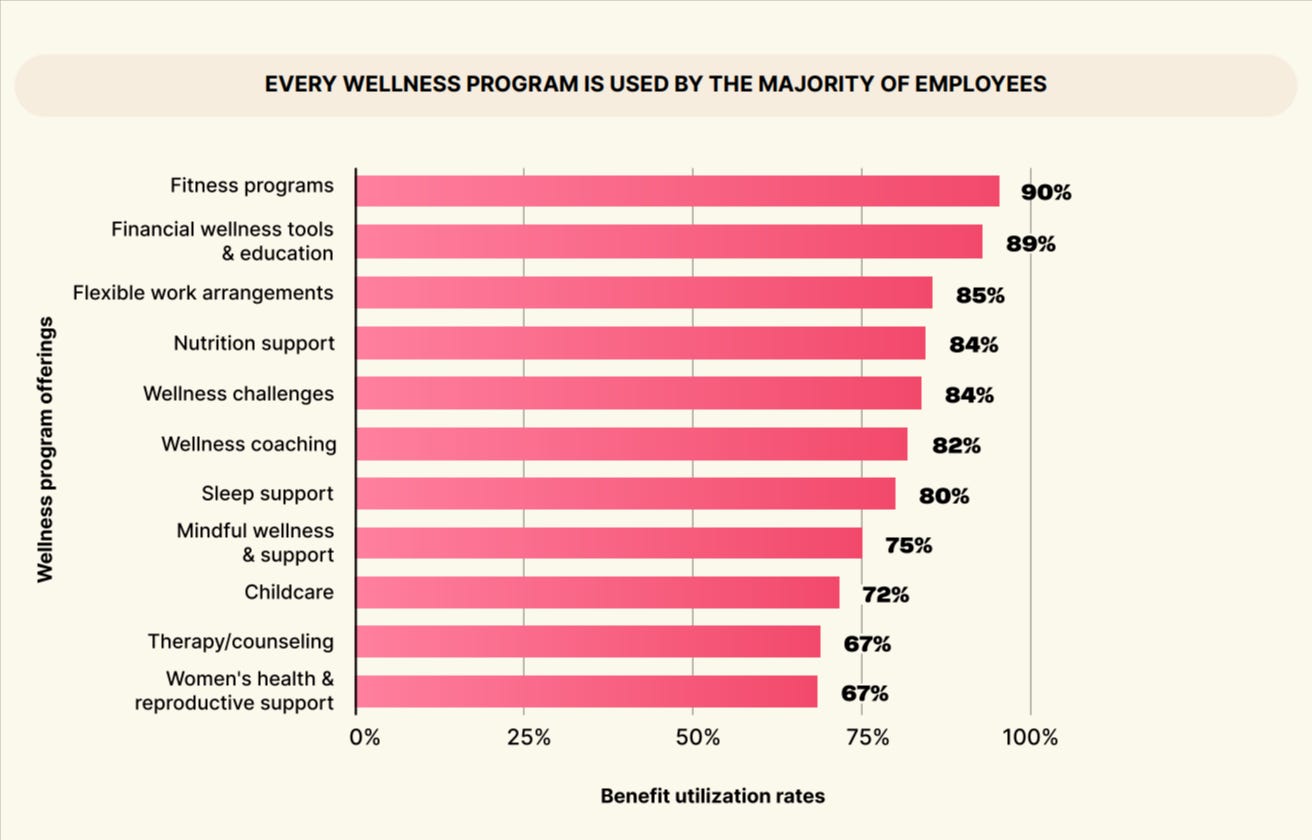Why Employee Wellness Programs Are Becoming Business Essentials
When you hear the term ‘employee wellness programs’ do you mostly assume that means your healthcare coverage, maybe a once a quarter fruit basket delivered to your door or a bit of forced in-office yoga sessions?
Fortunately, these programs have recently and rapidly involved to mean so much more. Today, employee wellness programs are multi-faceted initiatives designed to support everything from mental health and financial literacy to caregiving and overall career growth.
And for good reason: companies that are taking the lead in prioritizing employee well-being aren’t just being generous, they’re being strategic.
Recent data has shown a clear link between robust wellness offerings and true measurable business outcomes like reduced absenteeism, higher retention, improved moral and increased productivity. More companies are recognizing that workplace wellness is not a perk, and we are starting to see an increase in the amount of companies including these types of wellness benefits from day 1.
Here’s an example from the team over at Webflow:
The perks alone are enough to make you want to join the company! In fact, research has shown that a growing number of employees say they would consider leaving their jobs for a better benefits package, even if it meant taking a pay cut.
What Exactly Is a Workplace Wellness Program?
At its core, a workplace wellness program is a set of initiatives and benefits designed to support the physical, mental, emotional, and even financial well-being of employees.
A comprehensive wellness program often includes:
Mental Health Support: Access to therapy/counseling services, mindfulness apps, and stress management programs.
Physical Health Initiatives: Gym memberships, fitness classes, ergonomic furniture, and alternative therapies like massage or acupuncture.
Financial Wellness Programs: Financial education workshops, student loan repayment assistance, and personalized coaching.
Nutritional Support: Meal delivery services, cooking classes, or subsidies for healthy food programs.
Flexibility and Family Support: Generous parental leave, flexible work hours, remote work options, and childcare support.
Personal Development Resources: Tuition assistance, professional coaching, leadership training, and personal development workshops.
What a wellness program is not:
It’s important to note that wellness stipends are different from traditional insurance benefits like HSAs or FSAs. They’re flexible allowances designed to support well-being in ways that matter most to employees' day-to-day lives.
What Caused the Rise of Wellness Programs
Organizations are increasingly integrating wellness programs into their benefits packages—and not just because it’s trendy. Research shows tangible business results:
79% of employees with access to wellness programs actively utilize them, according to Wellhub’s 2025 State of Work-Life Wellness survey.
Employees enrolled in wellness programs report 70% higher job satisfaction than those without access to similar benefits.
Companies offering holistic wellness programs see absenteeism rates drop by 14-29%.
MetLife found that employees who are holistically healthy are 59% more likely to feel engaged and 53% more likely to be productive.
As Cesar Carvalho, CEO of Wellhub, put it:
"Wellbeing is no longer a perk; it’s a core business strategy. Leaders must prioritize holistic wellness support to build resilient, productive, and engaged workforces."
Companies Leading the Way in Employee Wellness
Several forward-thinking companies are setting the gold standard when it comes to investing in their employees’ total wellness.
Heavy-hitters like Microsoft, Asana, AirBnB, Ernst & Young and The Motley Fool are offering programs including:
Free gym memberships
Subsidized childcare and tuition assistance
$1,000 annual wellness stipend
Free daily meals prepared by culinary teams
Health, wellness, and hobby clubs
Onsite yoga facilities and nap rooms
$10K budget for ideal workspace setups
ps. did you know Asana has one of the highest employee satisfaction ratings and 99% of employees would recommend the company to a friend.
Based on research from Aflac’s 2025 Workforces Report the wellness benefits that most employees are using and are highly valued include:
Mental health services (therapy, mindfulness apps)
Flexible work arrangements (remote/hybrid options, flexible hours)
Financial wellness tools (retirement savings help, financial coaching)
Fitness and physical health supports (gym memberships, stipends)
Women’s health and family support (fertility assistance, childcare)
Nutritional and healthy lifestyle programs
In the End, Wellness Programs Are a Smart Investment
As shared earlier, wellness programs can reduce absenteeism by up to 29%. A MetLife study found that employees who are holistically healthy are 59% more likely to be engaged and 53% more likely to be productive. That translates to better output, lower turnover, and higher morale.
And companies are taking note. The 2024 Aflac WorkForces Report shows that while gaps still exist between employer assumptions and employee satisfaction, they’re shrinking. More organizations now recognize that benefits must match real needs—not assumptions.
Cutting back on benefits to trim budgets can be a costly mistake. Increasingly, employees are willing to walk away from higher salaries in favor of better wellness packages. In a tight talent market, holistic well-being isn't just a retention tool—it’s a competitive advantage.
Actions You Can Take Right Now
If your company offers a wellness program:
Take advantage of it! Explore all available benefits — from counseling to gym memberships — and prioritize your well-being.
Encourage your peers to participate too. Wellness programs are more impactful when embraced by entire teams.
If your company doesn’t have a wellness program:
Start the conversation. Gather data (like the stats above!) to show leadership the ROI on wellness investments.
Propose small pilots. Even starting with wellness stipends or a mental health day initiative can be a first step.
If you're a leader:
Model the behavior. Use wellness benefits yourself and talk openly about prioritizing well-being.
Create accessible programs. Build offerings based on employee feedback, not assumptions.
Invest long-term. Wellness is an ongoing commitment, not a one-time perk.
The future of work is human-centered, flexible, and focused on holistic well-being.
Organizations that embrace this reality will not just survive the evolving workplace — they’ll thrive.
Investing in employee wellness isn’t a luxury; it’s the smartest business decision you can make in 2025 and beyond.
Sources:
Work-Life Wellness 2025, 2025
The State of Workplace Benefits and Enrollment, Aflac WorkForces Report, 2024
2025 Employee Wellness Industry Trends Report, Wellable, 2025
Work-Life Wellness 2025 Executive Summary, Wellhub, 2025
Work-Life Wellness 2025 Full Report, Wellhub, 2025




